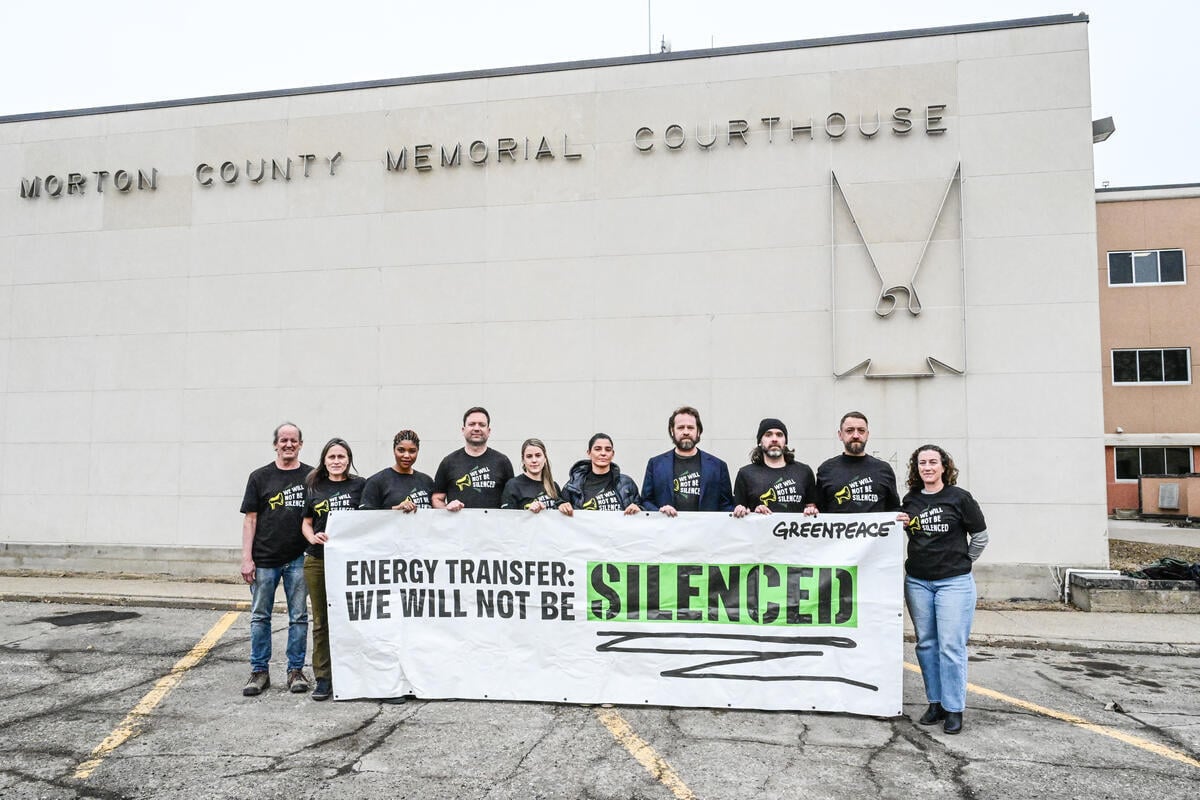Energy Transfer wants to shut us up, but we’ve never been very good at doing that.

In February 2025, Greenpeace USA is scheduled to go to trial in North Dakota. We are being sued by Energy Transfer – the operator of the Dakota Access Pipeline – for nearly $300 million related to the 2016 protests at Standing Rock. A loss in this trial could threaten to put Greenpeace on the sidelines of the fight for climate justice right at the moment when we need to fight even harder for a green and peaceful future.
The stakes are high, and not just for Greenpeace USA as an organization. This trial is testing out dangerous legal tactics that, if successful, could be widely applied against protesters, and indeed, anyone who speaks out or criticizes a deep-pocketed corporation.
No matter what happens, Greenpeace is not going away. But this legal threat is very real, and we see it as our duty to fight this lawsuit not just for ourselves, but for future activists who might be similarly targeted.
Energy Transfer wants to shut us up, but we’ve never been very good at doing that. Here is the story of this lawsuit and why it matters for all of us.
The Story of Standing Rock
2008 was the year that the fracking boom kicked into high gear. That was the year Sarah Palin said “drill, baby, drill” – and even though she lost that election, the U.S. government has basically followed the Palin Plan ever since. In fact, U.S. oil production has more than doubled since that year, making the U.S. the world’s largest oil producer … ever. This boom has also spurred the construction of pipelines, export terminals and other infrastructure, all of which lock us into more fossil fuel dependence, harm nearby communities, and undermine the slow progress we are making on meeting the Paris Agreement goals.
In North Dakota’s Bakken oil field, the fracking boom led to skyrocketing oil production, and soon the oil industry needed an easier method of getting its product to oil refineries and global markets. So in 2014, Energy Transfer and its partners proposed the Dakota Access Pipeline (DAPL) that would carry Bakken crude from North Dakota to Illinois, and then down to the Gulf Coast.
From the very start, members of the Standing Rock Sioux Tribe, along with other Sioux Nations, opposed the pipeline. Tribal chairman Dave Archambault put the pipeline in historical perspective: “Whether it’s gold from the Black Hills or hydropower from the Missouri or oil pipelines that threaten our ancestral inheritance, the tribes have always paid the price for America’s prosperity.”
Video: Standing Rock members describe the beginnings of of the #NoDAPL protests. Watch the full 19-part video series “Dakota Water Wars.”
Starting in April 2016 tribal members set up prayer encampments near the proposed water crossing, and young Water Protectors organized a 500-mile relay run to deliver a letter to the U.S. Army Corps of Engineers. In July 2016, Standing Rock filed a lawsuit against the Army Corps to block approval of the pipeline. As the construction of the “Black Snake” drew closer and closer to the river in summer and fall of 2016, the growing anti-pipeline protests captured national and then global attention.
Tens of thousands of people, including members of more than 300 tribal nations, traveled to protect the water and to show solidarity with Standing Rock. Many more people took action calling on the Obama administration to block the permits and petitioning banks to stop funding the project. In October 2016, United Nations representatives visited Standing Rock and voiced concerns about Indigenous sovereignty.
Then on November 8, 2016, Donald Trump was elected president. While the Obama administration had rejected the pipeline easement in December 2016, one of Trump’s first acts was to order the Army Corp to issue the easement. Energy Transfer CEO Kelcy Warren had recently donated $250,000 to his Inauguration, and later threw a fundraiser that raised $10 million to Trump’s 2020 re-election effort. Construction was completed and the pipeline went into operation in June 2017.
Although oil was flowing, the Standing Rock Sioux Tribe was not done fighting. Their lawsuit continued on, and in 2020 a federal judge ordered the Army Corps to conduct a full Environmental Impact Statement on the pipeline crossing. However, an order to shut down the pipeline was not upheld. A Draft EIS was released in September 2023, followed by public hearings in Bismarck, North Dakota in November 2023. A final decision on the pipeline will likely be made in 2025.
Today, the Standing Rock Sioux Tribe is still demanding that “the Corps shut the pipeline down and conduct a proper environmental review, not one prepared by the fossil fuel industry.”
The Empire Strikes Back
The fight against DAPL is still ongoing, but it is clear that the 2016 and 2017 Standing Rock protests were one of the most powerful displays of resistance to corporate power this country has seen in many years. Corporate leaders were clearly rattled by the strength of the movement. Since 2016, broad fossil fuel anti-protest laws have been enacted in 18 states. Close relationships between fossil fuel entities and government officials have s쳮ded in many efforts that shrink civic space and heighten the consequences for engaging in peaceful protest.
In the case of Energy Transfer, they turned to the courts.
Energy Transfer first sued Tribal Chairman Archambault and other Water Protectors for monetary damages (the case was later dismissed) and in 2017 sued Greenpeace in federal court. In a pair of 2017 media interviews, Warren talked about the rationale for the lawsuit. In one interview Warren stated that he was “absolutely” trying to “cease funding” for Greenpeace, and in another claimed that his “primary objective” was not recovering monetary damages but rather to “send a message, you can’t do this, this is unlawful and it’s not going to be tolerated in the United States.”
What’s more, this lawsuit may have been part of a coordinated effort to go after Greenpeace in particular. The same law firm that filed the ET suit had the year before filed a similar SLAPP suit against Greenpeace on behalf of Resolute Forest Products. Greenpeace finally won that lawsuit outright in 2023; the case was resolved in 2024 after nearly a decade of litigation. The firm in question – Kasowitz Benson Torres, founded by one of Trump’s personal attorneys – told Bloomberg that they were “in touch with other companies” that were thinking of suing Greenpeace.
This initial 2017 ET lawsuit was a truly wild piece of creative writing. The suit claims that Greenpeace – and not the Standing Rock Sioux Tribe or Indigenous water protectors – was the organizer behind the protests. Energy Transfer made all sorts of claims and drew far-fetched connections between nearly any group that ever criticized DAPL. The goal was to wrap everything up under the RICO statute, a law designed to combat organized crime, that would unlock punitive damages. Thankfully, a federal judge rejected these flimsy arguments and dismissed the federal racketeering claim in 2019.
But the judge never decided the state tort claims, and many of these same bad arguments reared their head again when Energy Transfer immediately refiled the suit in North Dakota state court.
The Criminalization of Ordinary Advocacy
Put quite simply, the current lawsuit accuses Greenpeace of things we did not do and attempts to criminalize ordinary public advocacy. A bad ruling in this case could have dire repercussions for anyone who attends a protest or who dares to speak up and criticize a powerful, deep-pocketed corporation.
You can read more about the dangerous arguments that ET is making here (see “6 Reasons Why Energy Transfer’s Lawsuit Against Greenpeace Is Outrageous”). But the big picture is that this lawsuit is an attack on two elements of ordinary, garden variety public advocacy – free speech and protest. Public advocacy like this should enjoy the strongest First Amendment protections, but the lawsuit rewrites the history of Standing Rock, twists it into a sinister caricature of itself, and then hangs an intimidating price tag of nearly $300 million on it.
When it comes to SLAPP suits like this one, the process itself is the punishment. The burden of time and money to defend constitutionally protected activities from such mischaracterizations is far too high for ordinary citizens and community organizations. As a result, many will decide to keep quiet rather than risk a ruinous judgment.



